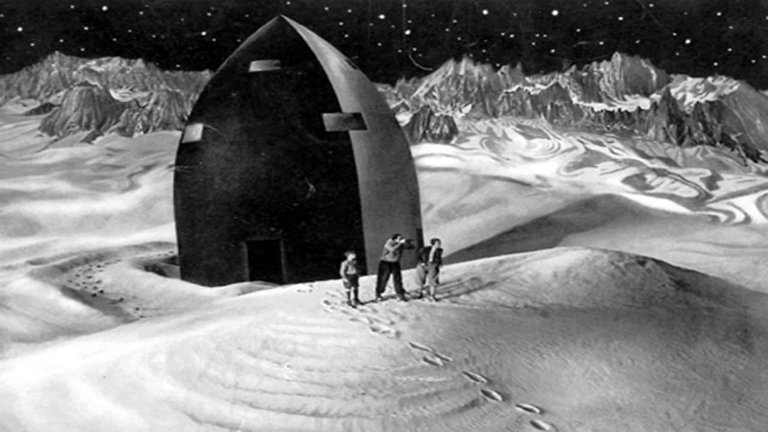Film Review: Woman in the Moon (Frau im Mond, 1929)

Some of the most influential science fiction films ever made weren’t among the best. That includes Woman in the Moon, 1929 German silent film directed by Fritz Lang, known not only as one of the most influential in the history of genre, but also the most influential science fiction film in general history.
Like Metropolis, Lang’s earlier film and science fiction classic, Woman in the Man is based on the novel by his then-wife Thea von Harbou, who also wrote screenplay. The plot begins when Wolf Helius (played by Willy Fritsch), head of aeronautics company, visits his old friend Professor Georg Manfeldt (played by Klaus Pohl), once respected scientist who became object of ridicule after his theories about large deposits of gold on the Moon and ability of humans to reach it via rocket. Helius informs Manfeldt that he has built a rocket and would launch expedition to test his theory, with himself invited. Helius, however, won’t bring his friend and trusted associate Hans Windengger (played by Gustav von Wangheim), partly because he just got engaged to beautiful astronomy student Friede Velten (played by Gerda Maurus) whom Helius secretly loves. Romantic problems prove secondary to more pressing issues in the form of thugs led by mysterious and menacing “Mr. Walter Turner” (played by Fritz Rasp) who harass Helius and steal his company plans. “Turner” finally reveals himself to work for powerful gold-mining syndicate whose interests could be threatened by eventual discovery of gold on the Moon. He issues ultimatum – either he will be allowed to travel on ship or the whole project would be sabotaged. Helius reluctantly agrees, just as he reluctantly agrees to bring Windegger and Friede to expedition. The launch of the rocket is a success, but while on the way to the Moon, Helius discovers that the ship had stowaway in the form of Gustav (played by Gustl Gstettenbaur), boy obsessed with astrophysics and pulp novels.
Woman in the Moon represents so-called “hard” science fiction or, in other words, belongs to relatively few science fiction films that take “science” seriously. This shouldn’t be that surprising, because Lang himself was fan of the genre but also inspired by great interest in rocketry and other emerging forms of technology that characterised the world and Weimar Germany in 1920s. Physicist Hermann Oberth, often called the father of German rocketry, served as Lang’s and Harbou’s technical advisor. It shows in the film, especially in the scenes depicting the rocket and its launch, which, even with relatively primitive special effects of its time look convincing and prophetic in light of events four decades later. Those details include use ramp for launching, use of water to absorb the heat of the launch blast, horizontal beds for crew to deal with G-force, multi-stage rockets and weightlessness during space flight.
Unfortuantely, those impressive scenes are preceded with overlong prologue which represents combination of weak thriller, cheap melodrama and mild comedy. Woman in the Moon becomes much less convincing with introduction of cheap stowaway, which makes it more pulpish. But the worst is the idea of Moon with breathable atmosphere, which is a concept that could have been passable in 19th Century, but not so much in late 1920s. This results with additional melodrama and scenes that look more like those in “Bergfilme” or “mountain films” that used to be popular in Germany in interwar period. As a result, Woman in the Moon is terribly overlong and would test patience of those unaccustomed to silent films. What helps film is a good cast, especially Klaus Pohl as eccentric scientist and Fritz Rasp as sinister villain, while Gerda Maurus isn’t that memorable as the title character. Woman in the Moon, despite being silent film in time when sound films were becoming the norm, was nevertheless popular in Germany, with Adolf Hitler, leader of ascedning Nazi Party, being one of its great fans. But even more important is the boost the film gave to Oberth and his disciples like Willy Ley and young Wernher von Braun. The latter credited Woman in the Moon as inspiration for his work on German top secret program that would result in V-2 missiles during WW2 and, after the war, serve as basis for NASA program that would bring men to the Moon. As such, Woman in the Moon represents one of the very rare if not the only science fiction films that directly led to some of its visions becoming reality.
RATING: 6/10 (++)
Blog in Croatian https://draxblog.com
Blog in English https://draxreview.wordpress.com/
Leofinance blog https://leofinance.io/@drax.leo
Cent profile https://beta.cent.co/@drax
Minds profile https://www.minds.com/drax_rp_nc
Uptrennd profile https://www.uptrennd.com/user/MTYzNA
Unstoppable Domains: https://unstoppabledomains.com/?ref=3fc23fc42c1b417
Hiveonboard: https://hiveonboard.com?ref=drax
Bitcoin Lightning HIVE donations: https://v4v.app/v1/lnurlp/qrcode/drax
Rising Star game: https://www.risingstargame.com?referrer=drax
1Inch: https://1inch.exchange/#/r/0x83823d8CCB74F828148258BB4457642124b1328e
BTC donations: 1EWxiMiP6iiG9rger3NuUSd6HByaxQWafG
ETH donations: 0xB305F144323b99e6f8b1d66f5D7DE78B498C32A7

Thanks for another informative review. It is amazing to think that a silent film would have such an impact on future events. Please excuse my ignorance for this question: is this film part of the 'naturalist' school you referred to in an earlier review?
No. Von Harbou and Lang were more into stuff like exotic adventures, conspiracies or hidden treasures than kitchen sink realism.